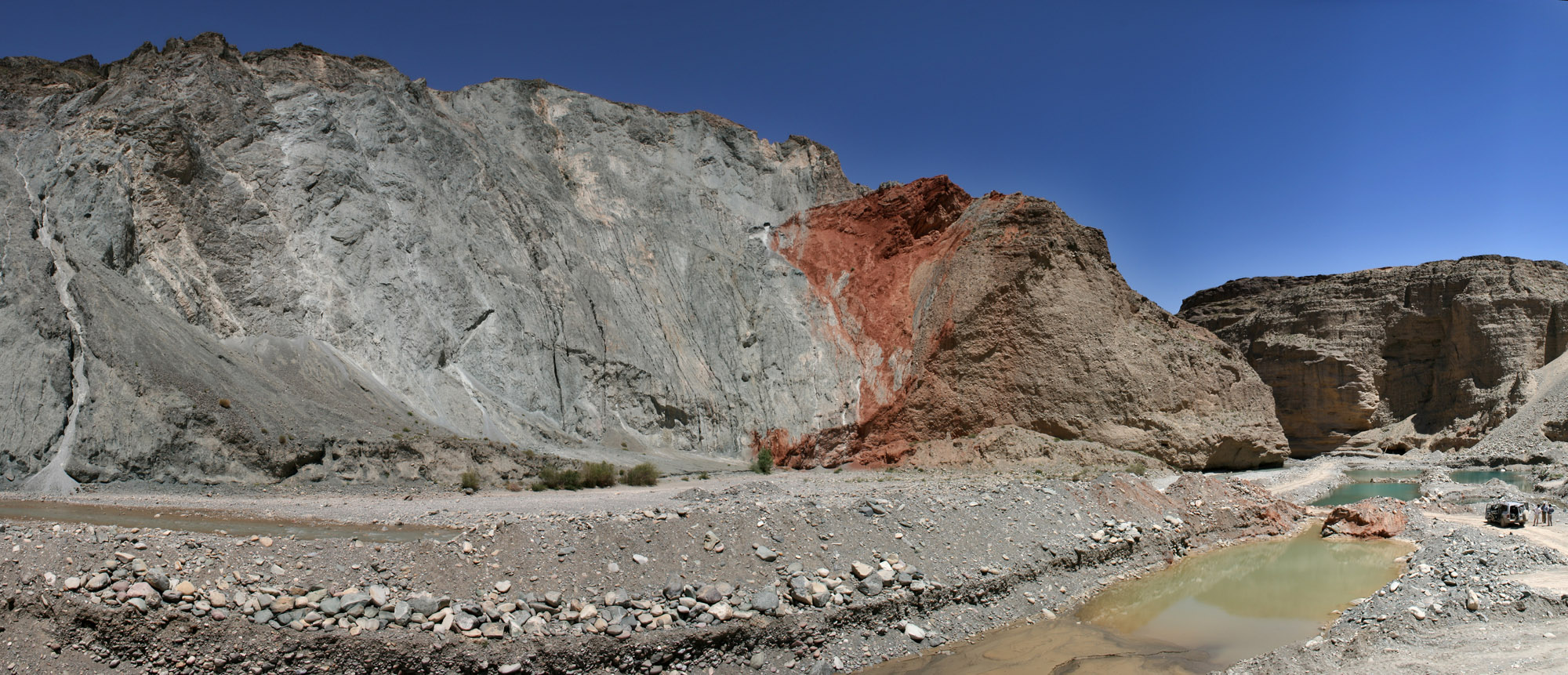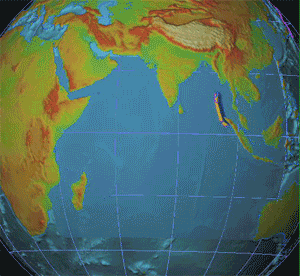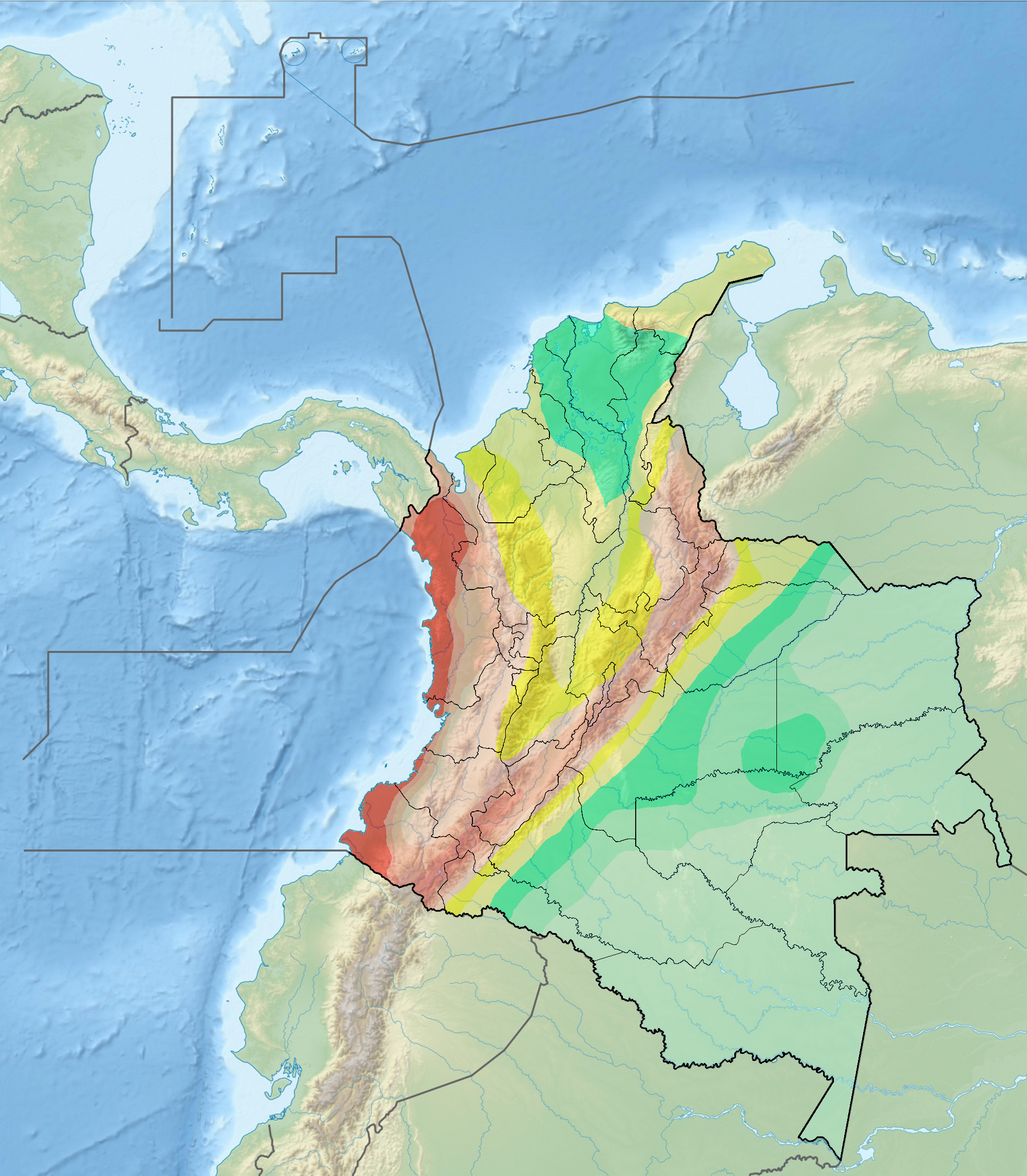|
Tarra Fault
The Tarra Fault () is a thrust fault in the department of Norte de Santander in Colombia. The fault has a total length of and runs along an average north-northeast to south-southwest strike of 007.6 ± 8 in the Eastern Ranges of the Colombian Andes. Etymology The fault is named after the Tarra River.Paris et al., 2000, p.12 Description The Tarra Fault is located northwest of the city of Cúcuta and Las Mercedes Fault. The fault thrusts Precambrian and Paleozoic rocks over Cretaceous rocks. It has a very pronounced morphologic expression along the base of the mountain front through the western side of the Tarra valley. The strong topographic signature of the scarp suggests, according to Page (1986), that the fault is as active as other known Quaternary faults in the region. The fault runs from El Tarra in the north to Hacari in the south.Plancha 66, 1980Plancha 76, 1980 See also * List of earthquakes in Colombia * Bucaramanga-Santa Marta Fault The Bucaramanga-Santa Mart ... [...More Info...] [...Related Items...] OR: [Wikipedia] [Google] [Baidu] |
Tarra River
The Tarra River is a river of Colombia. It drains into Lake Maracaibo via the Catatumbo River. Several discredited claims of large monkey-like creatures originated in this region. See also *List of rivers of Colombia Atlantic Ocean Amazon River Basin * Amazon River ** Guainía River or Negro River *** Vaupés River or Uaupés River **** Papuri River **** Querary River *** Isana River or Içana River **** Cuiari River *** Aquio River ** Caquetá River o ... References *Rand McNally, The New International Atlas, 1993. Rivers of Colombia {{Colombia-river-stub ... [...More Info...] [...Related Items...] OR: [Wikipedia] [Google] [Baidu] |
Precambrian
The Precambrian (or Pre-Cambrian, sometimes abbreviated pꞒ, or Cryptozoic) is the earliest part of Earth's history, set before the current Phanerozoic Eon. The Precambrian is so named because it preceded the Cambrian, the first period of the Phanerozoic Eon, which is named after Cambria, the Latinised name for Wales, where rocks from this age were first studied. The Precambrian accounts for 88% of the Earth's geologic time. The Precambrian is an informal unit of geologic time, subdivided into three eons ( Hadean, Archean, Proterozoic) of the geologic time scale. It spans from the formation of Earth about 4.6 billion years ago ( Ga) to the beginning of the Cambrian Period, about million years ago ( Ma), when hard-shelled creatures first appeared in abundance. Overview Relatively little is known about the Precambrian, despite it making up roughly seven-eighths of the Earth's history, and what is known has largely been discovered from the 1960s onwards. The Precambrian fos ... [...More Info...] [...Related Items...] OR: [Wikipedia] [Google] [Baidu] |
Thrust Faults
A thrust fault is a break in the Earth's crust, across which older rocks are pushed above younger rocks. Thrust geometry and nomenclature Reverse faults A thrust fault is a type of reverse fault that has a dip of 45 degrees or less. If the angle of the fault plane is lower (often less than 15 degrees from the horizontal) and the displacement of the overlying block is large (often in the kilometer range) the fault is called an ''overthrust'' or ''overthrust fault''. Erosion can remove part of the overlying block, creating a ''fenster'' (or ''window'') – when the underlying block is exposed only in a relatively small area. When erosion removes most of the overlying block, leaving island-like remnants resting on the lower block, the remnants are called ''klippen'' (singular ''klippe''). Blind thrust faults If the fault plane terminates before it reaches the Earth's surface, it is referred to as a ''blind thrust'' fault. Because of the lack of surface evidence, blind thr ... [...More Info...] [...Related Items...] OR: [Wikipedia] [Google] [Baidu] |
Seismic Faults Of Colombia
Seismology (; from Ancient Greek σεισμός (''seismós'') meaning " earthquake" and -λογία (''-logía'') meaning "study of") is the scientific study of earthquakes and the propagation of elastic waves through the Earth or through other planet-like bodies. It also includes studies of earthquake environmental effects such as tsunamis as well as diverse seismic sources such as volcanic, tectonic, glacial, fluvial, oceanic, atmospheric, and artificial processes such as explosions. A related field that uses geology to infer information regarding past earthquakes is paleoseismology. A recording of Earth motion as a function of time is called a seismogram. A seismologist is a scientist who does research in seismology. History Scholarly interest in earthquakes can be traced back to antiquity. Early speculations on the natural causes of earthquakes were included in the writings of Thales of Miletus (c. 585 BCE), Anaximenes of Miletus (c. 550 BCE), Aristotle (c. 340 ... [...More Info...] [...Related Items...] OR: [Wikipedia] [Google] [Baidu] |
INGEOMINAS
The Colombian Geological Survey (CGS) ( es, Servicio Geológico Colombiano; formerly known as INGEOMINAS) is a scientific agency of the Colombian government in charge of contributing to the socioeconomic development of the nation through research in basic and applied geosciences of the subsoil, the potential of its resources, evaluating and monitoring threats of geological origin, managing the geoscientific knowledge of the nation, and studying the nuclear and radioactive elements in Colombia. History The CGS was initially created as the ''National Scientific Commission'' ( es, Comisión Científica Nacional) by the Congress of Colombia on December 22, in 1916, with the mission of mapping the geological resources of the nation and exploring the national territory in search of mineral deposits. Following a series of earthquakes throughout the nation in the early 1920s, the eruption of the Galeras volcano in 1925, and the growing mining and petroleum industry, the Colombian gove ... [...More Info...] [...Related Items...] OR: [Wikipedia] [Google] [Baidu] |
United States Geological Survey
The United States Geological Survey (USGS), formerly simply known as the Geological Survey, is a scientific agency of the United States government. The scientists of the USGS study the landscape of the United States, its natural resources, and the natural hazards that threaten it. The organization's work spans the disciplines of biology, geography, geology, and hydrology. The USGS is a fact-finding research organization with no regulatory responsibility. The agency was founded on March 3, 1879. The USGS is a bureau of the United States Department of the Interior; it is that department's sole scientific agency. The USGS employs approximately 8,670 people and is headquartered in Reston, Virginia. The USGS also has major offices near Lakewood, Colorado, at the Denver Federal Center, and Menlo Park, California. The current motto of the USGS, in use since August 1997, is "science for a changing world". The agency's previous slogan, adopted on the occasion of its hundredth an ... [...More Info...] [...Related Items...] OR: [Wikipedia] [Google] [Baidu] |
Caño Tomás Fault
The Caño Tomás Fault () is a thrust fault in the department of Norte de Santander in northern Colombia. The fault has a total length of and runs along an average north-northeast to south-southwest strike of 011.4 ± 8 in the Eastern Ranges of the Colombian Andes. Etymology The fault is named after Caño Tomás a ''vereda'' of Teorama.Paris et al., 2000, p.11 Description The fault with a total length of is located about to the west of the town of Tibú, Norte de Santander, along the eastern base of the Eastern Ranges of the Colombian Andes. In the northern part, the fault places agglomerates and breccias of Jurassic to Triassic age against shales and sandstones of Cretaceous age. Farther south, it places Precambrian gneisses and migmatites against Cretaceous and Jurassic to Triassic rocks. The thrust fault, with an approximate strike of 011.4 ± 8 and dipping to the west, displaces the erosion surface of the Eastern Ranges about vertically according to a topographic su ... [...More Info...] [...Related Items...] OR: [Wikipedia] [Google] [Baidu] |
Bucaramanga-Santa Marta Fault
The Bucaramanga-Santa Marta Fault (BSMF, BSF) or Bucaramanga-Santa Marta Fault System ( es, (Sistema de) Falla(s) de Bucaramanga-Santa Marta) is a major oblique transpressional sinistral strike-slip fault (wrench fault) in the departments of Magdalena, Cesar, Norte de Santander and Santander in northern Colombia. The fault system is composed of two main outcropping segments, named Santa Marta and Bucaramanga Faults, and an intermediate Algarrobo Fault segment in the subsurface. The system has a total length of and runs along an average north-northwest to south-southeast strike of 341 ± 23 from the Caribbean coast west of Santa Marta to the northern area of the Eastern Ranges of the Colombian Andes. The fault system is a major bounding fault for various sedimentary basins and igneous and metamorphic complexes. The northern Santa Marta Fault segment separates the Sinú-San Jacinto Basin and Lower Magdalena Valley in the west from the Sierra Nevada de Santa Marta to the east. ... [...More Info...] [...Related Items...] OR: [Wikipedia] [Google] [Baidu] |
List Of Earthquakes In Colombia
This is a list of earthquakes in Colombia. Colombia is a seismically active country and has a large seismic risk in many areas of its territory due to its location at the boundaries of the Malpelo, Panama, Caribbean, North Andes (where most earthquakes occurred) and South American Plates along the Pacific Ring of Fire. The southeastern and extreme eastern portions of Colombia are not as seismically active as the rest of the country. The first historically registered earthquake felt in Colombia occurred on September 11, 1530, around 10:00 AM, probably with the epicentre near Cumaná, Venezuela. The earthquake was documented by Gonzalo Fernández de Oviedo y Valdés in his work ''La Historia general de las Indias'' and by friar Bartolomé de las Casas in his book ''Historia de Las Indias''.Ramírez, 1975, p.63 The first documented earthquake with its epicentre in present-day Colombia territory took place in 1566,Ramírez, 1975, p.65 with the epicentre estimated around San ... [...More Info...] [...Related Items...] OR: [Wikipedia] [Google] [Baidu] |
El Tarra
El Tarra is a Colombian municipality and town located in the department of Norte de Santander North Santander (Spanish: Norte de Santander) () is a department of Northeastern Colombia. It is in the north of the country, bordering Venezuela. Its capital is Cúcuta, one of the country's major cities. North Santander is bordered by Venez .... References *Government of Norte de Santander - El Tarra*El Tarra official website Municipalities of the Norte de Santander Department {{NortedeSantander-geo-stub ... [...More Info...] [...Related Items...] OR: [Wikipedia] [Google] [Baidu] |
Cretaceous
The Cretaceous ( ) is a geological period that lasted from about 145 to 66 million years ago (Mya). It is the third and final period of the Mesozoic Era, as well as the longest. At around 79 million years, it is the longest geological period of the entire Phanerozoic. The name is derived from the Latin ''creta'', " chalk", which is abundant in the latter half of the period. It is usually abbreviated K, for its German translation ''Kreide''. The Cretaceous was a period with a relatively warm climate, resulting in high eustatic sea levels that created numerous shallow inland seas. These oceans and seas were populated with now-extinct marine reptiles, ammonites, and rudists, while dinosaurs continued to dominate on land. The world was ice free, and forests extended to the poles. During this time, new groups of mammals and birds appeared. During the Early Cretaceous, flowering plants appeared and began to rapidly diversify, becoming the dominant group of plants across the Ear ... [...More Info...] [...Related Items...] OR: [Wikipedia] [Google] [Baidu] |







